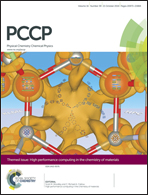Raman mapping investigation of chemical vapor deposition-fabricated twisted bilayer graphene with irregular grains
Abstract
Bilayer graphene as a prototype of two-dimensional stacked material has recently attracted great attention. The twist angle between graphene layers adds another dimension to control its properties. In this study, we used Raman mapping to investigate the twist angle dependence of properties of twisted bilayer graphene (TBG) with irregular grains that was fabricated by chemical vapor deposition (CVD). Different Raman parameters including intensity, width, and position of G and 2D peaks were used to distinguish TBG with different twist angles. The statistical results from Raman imaging on the distribution of twist angle are consistent with the results from selected area election diffraction (SAED). Finally, the Raman peak at approximately 1347 cm−1 for TBG with a large twist angle was assigned to the D-like peak, although it has similar excitation energy dependence of frequency as the defect-induced D peak. Theoretical calculation further confirmed that vacancy-like defect is not favored in the formation energy for TBG with a large twist angle as compared to monolayer graphene or TBG with other twist angles. These results will help to advance the understanding of TBG properties, especially for CVD samples with irregular grains.


 Please wait while we load your content...
Please wait while we load your content...